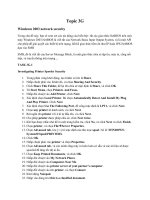15 network centrality
Bạn đang xem bản rút gọn của tài liệu. Xem và tải ngay bản đầy đủ của tài liệu tại đây (49.59 MB, 63 trang )
• HW3 deadline on Thu, midnight!.
• We will provide feedback about the
Project Milestone ASAP -- possibly
by the end of this week.
CS224W: Social and Information Network Analysis
Jure Leskovec and Baharan Mirzasoleiman, Stanford
Given a social network, which nodes are more
important or influential?
¡ Centrality measures were proposed to
account for the importance of the nodes of a
network
¡
11/26/18
Jure Leskovec, Stanford CS224W: Social and Information Network Analysis,
2
¡
Centrality is used often for detecting:
§ How influential a person is in a social network?
§ How well used a road is in a transportation network?
§ How important a web page is?
[Wu and He’15]
11/26/18
Jure Leskovec, Stanford CS224W: Social and Information Network Analysis,
3
Geometric Measures:
§ Importance is a function of distances to other nodes.
¡ Spectral Measures:
§ Based on the eigen-structure of some graph-related matrix
¡ Path-based Measures:
§ Take into account all (shortest) paths coming into a node
¡
(Path based)
(Geometric)
(Geometric)
11/26/18
(Spectral)
Jure Leskovec, Stanford CS224W: Social and Information Network Analysis,
4
¡
Geometric measures
§ (In-)Degree Centrality: The number of incoming
links
!"#$ (&) = )*+ (&)
§ Or equivalently, number of
nodes at distance one
§ Equivalent to majority
voting
11/26/18
Jure Leskovec, Stanford CS224W: Social and Information Network Analysis,
6
¡
Geometric measures
§ Closeness Centrality: Who are the bridges?
§ Nodes that are more central have smaller distances
1
!"#$% (') =
∑, -(., ')
length of the shortest path from y to x
§ Nodes that are more central
have smaller distances, and
higher centrality
11/26/18
Jure Leskovec, Stanford CS224W: Social and Information Network Analysis,
7
¡
Geometric measures
§ Closeness Centrality:
1
!"#$% (') =
∑, -(., ')
length of the shortest path from x to y
§ How much a vertex can communicate without relying on
third parties for his messages to be delivered
0.1
0.14
A
B
00123
0.16
C
5
4 =
= :. 5
5+7+8+9
0.14
0.1
D
E
§ Problem: The graph must be (strongly) connected!
11/26/18
Jure Leskovec, Stanford CS224W: Social and Information Network Analysis,
8
!"##
!"##
!"##
!"##
0.1
0.1
0.16
!"##
0.1
!"##
!"##
!"##
0.1
0.1
We get null score for all nodes,
if the graph is not connected!
11/26/18
1
$%&'( (*) =
∑/ 0(1, *)
Jure Leskovec, Stanford CS224W: Social and Information Network Analysis,
9
¡
Geometric measures
§ Harmonic Centrality: Who are the bridges?
§ Replace the average distance with the harmonic mean of
all distances.
§ The !(! − 1) distances between every pair of distinct
nodes:
1
&'() (*) = ,
=
0(1, *)
Harmonic mean -./
,
3 -,/ 45,-./
1
0(1, *)
§ Strongly correlated to closeness centrality
§ Naturally also accounts for nodes 1 that cannot reach *
§ Can be applied to graphs that are not strongly connected
11/26/18
Jure Leskovec, Stanford CS224W: Social and Information Network Analysis,
10
! ! ! ! !
"#$%& = + + + + = ). ! ) ) * +
2.5
2.5
3.8
3.5
3
3
5
3.1
3
2.5
11/26/18
!
!
3
3
Jure Leskovec, Stanford CS224W: Social and Information Network Analysis,
11
Red nodes are closer to all
the other nodes
Red nodes are closer to all the other
nodes, and have larger degrees
Examples of Closeness centrality, and Harmonic Centrality of the same graph.
11/26/18
Jure Leskovec, Stanford CS224W: Social and Information Network Analysis,
12
¡
Spectral measures
§ Compute the left dominant eigenvector of some
matrix derived from the graph
§ Idea: A node’s centrality is a function of the centrality
of its neighbors
§ Nodes connected to central nodes has a larger centrality score
than those connected to non-central nodes.
§ Eigenvector Centrality
§ Katz’s Index
§ Page Rank
§ Hits
Degree centrality
11/26/18
Eigenvector centrality
Jure Leskovec, Stanford CS224W: Social and Information Network Analysis,
14
¡
Spectral measures
§ Eigenvector Centrality: Measure of the
influence of a node in a network
§ Idea: Every node starts with the same score,
and then each node gives away its score to its
successors
'
!"#$ % = ( ∑*→, !"#$ Normalization constant = ./01
§
11/26/18
2
Intuitively: Degree counts walks of
length one, the eigenvalue centrality
counts walks of length infinity
Jure Leskovec, Stanford CS224W: Social and Information Network Analysis,
15
¡
Spectral measures
§ Eigenvector Centrality: Measure of the influence of a
node in a network:
1
!"#$ % = ) !"#$ (
*→,
§ !"#$ converges to the dominant eigenvector of adj. matrix /
§ ( converges to the dominant eigenvalue of adj. matrix /
§ Equivalently, eigencentrality is the eigenvector correspond
to the dominant eigenvalue (() of /
/0 = (0
§ Problem: Graph should be strongly connected!
11/26/18
if ∑
Jure Leskovec, Stanford CS224W: Social and Information Network Analysis,
16
¡
Power Iteration:
§ Set !(#) ← 1, ( ← 1
§ 1: !()) ← *!()+,)
§ 2: !()) = !()) / !())
2
4
3
5
1
2
§ 3: If !()) − !()+,) > 2:
§ 4:
( ← ( + 1, goto 1
1 2
0
1
4= 1
0
0
11/26/18
1
0
1
1
1
3 4 5
1
1
0
0
1
0
1
0
0
0
0
1
1
0
0
1
2
3
4
5
1
1
6= 1
1
1
Jure Leskovec, Stanford CS224W: Social and Information Network Analysis,
17
¡
Power Iteration:
Iteration 1
Iteration 2
Iteration 3
11/26/18
1
2
3
4
5
1 2
0
1
1
0
0
1
0
1
1
1
3 4 5
1
1
0
0
1
/
0
1
0
0
0
0
1
1
0
0
1
1
1
1
1
0(2)
0.34
2
1
0.68
4
= 3 ≡ 0.51
1
0.17
2
0.34
0(4) = /0(2) 0(4) = 0(4) / 0(4)
0
1
1
0
0
1
0
1
1
1
1
1
0
0
1
0
1
0
0
0
0
1
1
0
0
0.34
1.19
0.45
0.68
1.36
0.51
0.51 = 1.36 ≡ 0.51
0.68
0.17
0.25
1.19
0.34
0.45
0
1
1
0
0
1
0
1
1
1
1
1
0
0
1
0
1
0
0
0
0
1
1
0
0
0.38
0.45
1.02
0.62
0.51
1.66
0.51 = 1.41 ≡ 0.53
0.51
0.19
0.25
1.02
0.38
0.45
…
2
4
3
5
Nor
6
1
1.41
. = 1.27
0.52
1
Jure Leskovec, Stanford CS224W: Social and Information Network Analysis,
18
Eigenvalue centrality counts walks of length infinity
11/26/18
Jure Leskovec, Stanford CS224W: Social and Information Network Analysis,
19
¡
Spectral measures
§ Katz’s Index: Measures influence by taking into
account the total number of walks between a pair
of nodes
*
*
∑
!"#$% & = ( ∑1
2
*+, .→0
&3
Total number of walks
of length k between x, y
6
0, 7 , where 8 is the
§ 1 is an attenuation factor in range
largest eigenvalue of 2
§ 9 is to give some nodes more privilege
§ Long paths are weighted less than short ones
11/26/18
Jure Leskovec, Stanford CS224W: Social and Information Network Analysis,
20
¡
Spectral measures
§ Katz’s Index: Measures influence by taking into account
the total number of walks between a pair of nodes
- ∑
* 2*
∑
!
&
=
(
1
,
"#$%
.→0
&3
*+,
2 =A
0
1
4
2 = 1
0
0
0
1
7
2 = 1
0
0
1
0
1
1
1
1
0
1
1
1
1
1
0
0
1
1
1
0
0
1
0
1
0
0
0
0
1
0
0
0
0
1
1
0
0
0
1
1
0
0
0
1
;
2 = 1
0
0
1
0
1
1
1
1
1
0
0
1
0
1
0
0
0
0
1
1
0
0
11/26/18
> < @: Long paths
are weighted less
7
;
2
1
= 1
1
2
1
4
2
0
1
1
2
3
1
1
1
0
1
1
1
2
1
1
1
2
2
6
= 5
1
2
6
4
6
4
6
5
6
4
2
5
1
4
2
0
1
2
6
5
1
2
Total number of walks
of length k between x, y
2
4
3
5
1
Number of walks of
length 3 between 2, 5
(2,1,3,5), (2,4,2,5), (2,3,2,5),
(2,1,2,5), (2,5,3,5), (2,5,2,5)
Jure Leskovec, Stanford CS224W: Social and Information Network Analysis,
21
¡
Spectral measures
§ Katz’s Index: Give each node a small amount of centrality
for free
!"#$% & = ( ) !-#$% . + 0
Normalization constant
¡
*→,
Power Iteration:
§
§
§
§
11/26/18
Set 1(3) ← 1, 8 ← 1
1: 1(9) ← (:1(9;<) + 0<
2: If 1(9) − 1(9;<) > ?:
3:
8 ← 8 + 1, goto 1
2
4
3
5
1
Jure Leskovec, Stanford CS224W: Social and Information Network Analysis,
22
¡
Spectral measures
§ Katz’s Index: Suitable for directed acyclic graphs
§ How to choose !?
§ For ! close to 0, the contribution given by paths longer than
one rapidly declines, and thus
§ Katz scores are mainly influenced by short paths (mostly indegrees)
§ When the ! is large, long paths are devalued smoothly, and
§ Katz scores are more influenced the by topology of the network
§ The measure diverges at " >
$
%
§ The dominant eigenvector of & is the limit of Katz centrality as
" approaches 1/) from below
11/26/18
Jure Leskovec, Stanford CS224W: Social and Information Network Analysis,
23
More paths of length > 1
end up at node u,
compared to node v
v
! = 0.15
"=1
#=2
u
! = 0.85
"=1
The red node and all nodes reachable
from it increase their centrality.
longer paths
are important
! = 0.15
"=1
short paths are important
11/26/18
Jure Leskovec, Stanford CS224W: Social and Information Network Analysis,
24
They are closer to all
the other nodes
They have largest
degrees
A
B
Lots of paths passing
through these nodes
They are closer to all
the other nodes, and
have larger degrees
C
D
Examples of A) Degree centrality, B) Closeness centrality, C) Harmonic
Centrality and D) Katz centrality of the same graph.
11/26/18
Jure Leskovec, Stanford CS224W: Social and Information Network Analysis,
25









